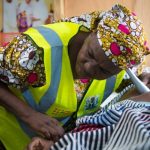In a society like Nigeria that places a premium on childbearing and sees those who have no children as worthless, for many who cannot “naturally” conceive- Nigeria has a 30.3% rural infertility rate- the price for the miracle of a baby can be costly.
Couples in Nigeria have sometimes become desperate and subject themselves to all manner of rituals to hear the cry of their own baby.
Like Ngozi and Okechukwu, their efforts to get a child for eight years were fruitless.
“I was going from pillar to post, believing everything I heard and was misled severally,” Ngozi said.
Ngozi and Okechukwu’s miracle happened when they opted for IVF or In Vitro fertility, an assisted reproductive technology, which works by using a combination of medicines and surgical procedures to help the sperm fertilise an egg and allow the fertilized egg implant in the uterus.
“At the end of it all, we opted for IVF.” Ngozi recalled, “I had challenges, but I had my mindset to achieve what I wanted. I borrowed, begged, saved, and, along with my husband, I raised money for the IVF cycle. It was a team effort. And we succeeded,”
In a country often described as the poverty capital of the world, access to these miracles comes at a substantial financial cost, and as Ngozi described, they borrowed, begged and saved to afford the IVF.
Fertility clinics in Nigeria, such as Bloom Fertility Clinic, prices for an IVF go as much as 2 million naira. A luxury that 88.4 million Nigerians can’t afford.
Why is IVF expensive in Nigeria?
Dr Sunday Onu, the medical director of Dede Hospital in Abuja, revealed that the cost of IVF procedures in Nigeria is costly because the equipment used by IVF clinics in Nigeria is imported.
“When you talk about IVF, yes, indeed, it is very expensive; if you ask me, I say why it is very expensive is because 100 % of things used in IVF are imported, and as the exchange rate is skyrocketing, the cost of providing this technology is also skyrocketing.”
Importing and maintaining these technologies incur significant expenses passed to patients.
IVF procedures demand a highly skilled team of medical professionals: fertility specialists, embryologists, technicians and many more. The lack of well-trained experts in this field often calls for professionals from abroad, further adding to the costs.
Dr Sunday Onu gave another reason: the inconsistent power supply. To maintain health services, backup generators and alternative power sources are used, contributing to IVF clinics’ overall costs.
“The problem of power is a major one in the health industry because, in a hospital, we must run 24/7 on power. We cannot afford to go out of power for one minute… and The cost of diesel, which is an alternative power supply, is astronomical. It is so unbelievable now, and all these are making delivery of quality healthcare at an affordable rate difficult.”
He urged the government to get involved in the health sector and mandate the power company holdings to prioritise hospitals.
While noting the value of empowering parenthood via IVF, the financial constraints on intending couples should be considered.
The argument for making IVF more accessible
Dr Pascale Allotey, WHO’s Director of Sexual and Reproductive Health and Research, spoke about a “medical poverty trap”. This refers to the catastrophic healthcare costs millions face when seeking infertility treatment, proposing a need for governments to fund IVF better.
“The sheer proportion of people affected shows the need to widen access to fertility care and ensure this issue is no longer sidelined in health research and policy so that safe, effective and affordable ways to attain parenthood are available,” added Tedros Adhanom Ghebreyesus, WHO Director-General.
Beyond affecting individuals’ and families’ finances positively, making IVF more affordable gives couples (from different backgrounds) equal opportunities to explore options for starting a family.
Infertility can lead to stigma and isolation. Making IVF affordable and accessible can normalise conversations around infertility and encourage couples to seek the medical help they need without fear of judgment.
Accessible IVF treatments could potentially lead to birth rates, which can contribute to economic growth in the long run. A growing population would lead to an expanded workforce, consumer base and increased demand for goods and services.
This would necessitate investments in the health infrastructure, training of medical professionals and development of fertility clinics. This, in turn, could improve the health sector overall, benefitting the nation beyond infertility treatments.
Affordable IVF could promote research and development in assisted reproductive technology, leading to the discovery of cost-effective treatments and procedures.
Ultimately, the miracle of having a child should be accessible to all.
In Nigeria, where childbearing is highly valued, infertile couples often face immense social pressure and stigma. This has led many to pursue costly assisted reproductive technologies like IVF. With a rural infertility rate of 30.3%, couples like Ngozi and Okechukwu have struggled for years to conceive, resorting to expensive procedures that have required significant financial sacrifices, including borrowing and saving.
IVF costs in Nigeria are exceptionally high, often around 2 million naira, due to the need for imported equipment and the involvement of highly skilled professionals. Other factors like inconsistent power supply also contribute to these expenses.
There's a growing call for making IVF more accessible. Dr. Pascale Allotey from the WHO highlights the financial burden of infertility treatments as a “medical poverty trap,” advocating for better government support. Affordable IVF could not only alleviate financial stress but also reduce social stigma, normalize infertility conversations, and potentially contribute to economic growth by boosting birth rates. Investments in health infrastructure and local training could also improve Nigeria's overall health sector.
The goal is to make the dream of parenthood accessible to all, regardless of economic status.






